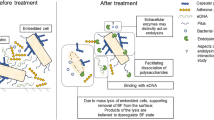Abstract
α-Toxin, one of the best known pore-forming proteins produced by Staphylococcus aureus (S. aureus), is a critical virulence factor in multiple infections. The necessity of α-toxin for S. aureus pathogenicity suggests that this toxin is an important target for the development of a potential treatment strategy. In this study, we showed that lysionotin, a natural compound, can inhibit the hemolytic activity of culture supernatants by S. aureus by reducing α-toxin expression. Using real-time PCR analysis, we showed that transcription of hla (the gene encoding α-toxin) and agr (the locus regulating hla) was significantly inhibited by lysionotin. Lactate dehydrogenase and live/dead assays indicated that lysionotin effectively protected human alveolar epithelial cells against S. aureus, and in vivo studies also demonstrated that lysionotin can protect mice from pneumonia caused by S. aureus. These findings suggest that lysionotin is an efficient inhibitor of α-toxin expression and shows significant protection against S. aureus in vitro and in vivo. This study supports a potential strategy for the treatment of S. aureus infection by inhibiting the expression of virulence factors and indicates that lysionotin may be a potential treatment for S. aureus pneumonia.




Similar content being viewed by others
References
Bubeck Wardenburg J, Patel RJ, Schneewind O (2007) Surface proteins and exotoxins are required for the pathogenesis of Staphylococcus aureus pneumonia. Infect Immun 75(2):1040–1044. doi:10.1128/IAI.01313-06
Bubeck Wardenburg J, Schneewind O (2008) Vaccine protection against Staphylococcus aureus pneumonia. J Exp Med 205(2):287–294. doi:10.1084/jem.20072208
Chen JW, Zhu ZQ, Hu TX, Zhu DY (2002) Structure-activity relationship of natural flavonoids in hydroxyl radical-scavenging effects. Acta Pharmacol Sin 23(7):667–672
Escaich S (2008) Antivirulence as a new antibacterial approach for chemotherapy. Curr Opin Chem Biol 12(4):400–408. doi:10.1016/j.cbpa.2008.06.022
Gordon RJ, Lowy FD (2008) Pathogenesis of methicillin-resistant Staphylococcus aureus infection. Clin Infect Dis 46(Suppl 5):S350–S359. doi:10.1086/533591
Gouaux E (1998) alpha-Hemolysin from Staphylococcus aureus: an archetype of beta-barrel, channel-forming toxins. J Struct Biol 121(2):110–122. doi:10.1006/jsbi.1998.3959
McElroy MC, Harty HR, Hosford GE, Boylan GM, Pittet JF, Foster TJ (1999) Alpha-toxin damages the air-blood barrier of the lung in a rat model of Staphylococcus aureus-induced pneumonia. Infect Immun 67(10):5541–5544
Micek ST, Dunne M, Kollef MH (2005) Pleuropulmonary complications of Panton-Valentine leukocidin-positive community-acquired methicillin-resistant Staphylococcus aureus: importance of treatment with antimicrobials inhibiting exotoxin production. Chest 128(4):2732–2738. doi:10.1378/chest.128.4.2732
Nguyen VT, Kamio Y (2004) Cooperative assembly of beta-barrel pore-forming toxins. J Biochem 136(5):563–567. doi:10.1093/jb/mvh160
Ohlsen K, Ziebuhr W, Koller KP, Hell W, Wichelhaus TA, Hacker J (1998) Effects of subinhibitory concentrations of antibiotics on alpha-toxin (hla) gene expression of methicillin-sensitive and methicillin-resistant Staphylococcus aureus isolates. Antimicrob Agents Chemother 42(11):2817
Padmanabhan RA, Fraser TG (2005) The emergence of methicillin-resistant Staphylococcus aureus in the community. Cleve Clin J Med 72(3):235–241
Parker D, Prince A (2012) Immunopathogenesis of Staphylococcus aureus pulmonary infection. Semin Immunopathol 34(2):281–297. doi:10.1007/s00281-011-0291-7
Qiu J, Niu X, Dong J, Wang D, Wang J, Li H, Luo M, Li S, Feng H, Deng X (2012a) Baicalin protects mice from Staphylococcus aureus pneumonia via inhibition of the cytolytic activity of alpha-hemolysin. J Infect Dis 206(2):292–301. doi:10.1093/infdis/jis336
Qiu J, Niu X, Wang J, Xing Y, Leng B, Dong J, Li H, Luo M, Zhang Y, Dai X, Luo Y, Deng X (2012b) Capsaicin protects mice from community-associated methicillin-resistant Staphylococcus aureus pneumonia. PLoS One 7(3):e33032. doi:10.1371/journal.pone.0033032
Rasko DA, Sperandio V (2010) Anti-virulence strategies to combat bacteria-mediated disease. Nat Rev Drug Discov 9(2):117–128. doi:10.1038/nrd3013
Recsei P, Kreiswirth B, O'Reilly M, Schlievert P, Gruss A, Novick RP (1986) Regulation of exoprotein gene expression in Staphylococcus aureus by agar. Mol Gen Genet 202(1):58–61
Suksamrarn A, Poomsing P, Aroonrerk N, Punjanon T, Suksamrarn S, Kongkun S (2003) Antimycobacterial and antioxidant flavones from Limnophila geoffrayi. Arch Pharm Res 26(10):816–820
Tan SY, Tatsumura Y (2015) Alexander Fleming (1881–1955): discoverer of penicillin. Singap Med J 56(7):366–367
Uhlemann AC, Otto M, Lowy FD, DeLeo FR (2014) Evolution of community- and healthcare-associated methicillin-resistant Staphylococcus aureus. Infect Genet Evol 21:563–574. doi:10.1016/j.meegid.2013.04.030
Vardakas KZ, Matthaiou DK, Falagas ME (2009) Incidence, characteristics and outcomes of patients with severe community acquired-MRSA pneumonia. Eur Respir J 34(5):1148–1158. doi:10.1183/09031936.00041009
Wang J, Qiu J, Dong J, Li H, Luo M, Dai X, Zhang Y, Leng B, Niu X, Zhao S, Deng X (2011) Chrysin protects mice from Staphylococcus aureus pneumonia. J Appl Microbiol 111(6):1551–1558. doi:10.1111/j.1365-2672.2011.05170.x
Wang J, Zhou X, Li W, Deng X, Deng Y, Niu X (2016) Curcumin protects mice from Staphylococcus aureus pneumonia by interfering with the self-assembly process of alpha-hemolysin. Sci Rep 6:28254. doi:10.1038/srep28254
Wunderink RG, Rello J, Cammarata SK, Croos-Dabrera RV, Kollef MH (2003) Linezolid vs vancomycin: analysis of two double-blind studies of patients with methicillin-resistant Staphylococcus aureus nosocomial pneumonia. Chest 124(5):1789–1797
Acknowledgments
This study was funded by the National Basic Research Program of China (No. 2013CB127205) and the National Natural Science Foundation of China (grant 31602109).
Author information
Authors and Affiliations
Corresponding authors
Ethics declarations
Conflict of interest
The authors declare that they have no conflict of interest.
Ethical approval
All applicable international, national, and/or institutional guidelines for the care and use of animals were followed.
Rights and permissions
About this article
Cite this article
Teng, Z., Shi, D., Liu, H. et al. Lysionotin attenuates Staphylococcus aureus pathogenicity by inhibiting α-toxin expression. Appl Microbiol Biotechnol 101, 6697–6703 (2017). https://doi.org/10.1007/s00253-017-8417-z
Received:
Revised:
Accepted:
Published:
Issue Date:
DOI: https://doi.org/10.1007/s00253-017-8417-z




